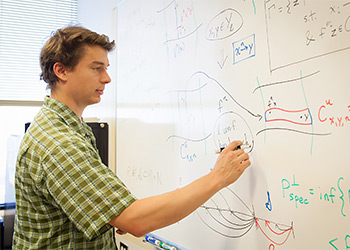Vaughn Climenhaga: NSF CAREER Award Recipient
Research Focuses on the Mathematical Study of Predictability Interspersed With Randomness
The world we live in can be both random and predictable.

NSF CAREER Award recipient, Vaughn Climenhaga, studies the mathematical basis of
predictability interspersed with randomness.Vaughn Climenhaga, assistant professor in the Department of Mathematics at the University
of Houston, is working on the mathematical study of predictability interspersed with
randomness, a concept known as non-uniform hyperbolicity. For this research, Climenhaga
was awarded a prestigious five-year, $500,000 National Science Foundation (NSF) CAREER
Award.
NSF CAREER Awards are granted to promising junior faculty who exemplify the role of teacher-scholars through “outstanding research, excellent education and the integration of education and research.” This grant will fund Climenhaga’s research as well as provide support for a summer workshop on dynamical systems aimed at preparing early-career mathematicians.
Hyperbolicity: Small Changes in Starting Conditions Lead to Unpredictable Changes in Outcome
“Hyperbolicity is the phenomenon of small changes in starting conditions getting blown up very quickly, leading to significantly different outcomes and unpredictable results,” said Climenhaga, who joined the College of Natural Sciences and Mathematics in 2012. In popular culture, this has been described as “chaos theory” and “the butterfly effect,” with the hypothetical question: ‘Does the flap of a butterfly’s wings in Brazil set off a tornado in Texas?’
This dramatic amplification of small changes in starting conditions is why, even though we understand the mechanics of how weather works, even the most sophisticated weather-prediction models can only predict a few days ahead. As precise as weather measurements are, tiny changes in starting conditions lead to very unpredictable results.
However, even randomness has an order to it that can be explained with mathematical principles. With weather, although day-to-day conditions cannot be predicted accurately for more than a few days in advance, over the span of months and years, seasons change in predictable ways.
Two Types of Hyperbolicity: Uniform and Non-Uniform
Within hyperbolicity, there are different behaviors of randomness: uniform and non-uniform. Uniform hyperbolicity generates randomness all the time, while non-uniform switches between random and predictable.
“With non-uniform hyperbolicity, there will be sudden moments where the different
states of the system separate very quickly, going from predictable to random,” Climenhaga
said.
An example of non-uniform hyperbolicity would be throwing a pair of dice. When the
dice is flying through the air, it behaves in a way that is predictable and not too
sensitive to small changes in the initial conditions. When the dice lands, there is
a fraction of time when a very tiny change, such as the angle at which it lands, has
a significant impact on the final outcome, generating randomness.
Extrapolating Techniques from Uniform to Non-Uniform Hyperbolicity
“For uniform hyperbolicity, we have a pretty solid underlying theory of how it works. However, most chaotic systems in the real world are non-uniformly hyperbolic. We’d like to have the same level of theoretical development for non-uniformly hyperbolic systems,” Climenhaga said. “I plan to extrapolate some of the techniques used in uniformly hyperbolic systems to non-uniformly hyperbolic systems.”
Grant to Support Houston Summer School on Dynamical Systems
A portion of this grant will be used to fund the Houston Summer School on Dynamical Systems, which is an annual workshop hosted by the Department of Mathematics and offered to graduate students from around the country. The nine-day workshop, which is funded by a separate NSF grant, takes place in May and offers full support to students who attend, including travel and local expenses.
Funds from Climenhaga’s CAREER award will offer full support for undergraduates to attend. In the fourth and fifth year of this grant, this workshop will be expanded to include a research conference at the end of program. Matthew Nicol, chair of the Department of Mathematics, is involved with the program, along with faculty members William Ott and Andrew Török.
“We want to give students the opportunity to participate in a research conference after having a week-and-a-half of lectures on these specific topics. This way, they’ll be able to get more out of the conference and make the connections that are so important for their careers,” Climenhaga said.
- Rachel Fairbank, College of Natural Sciences and Mathematics